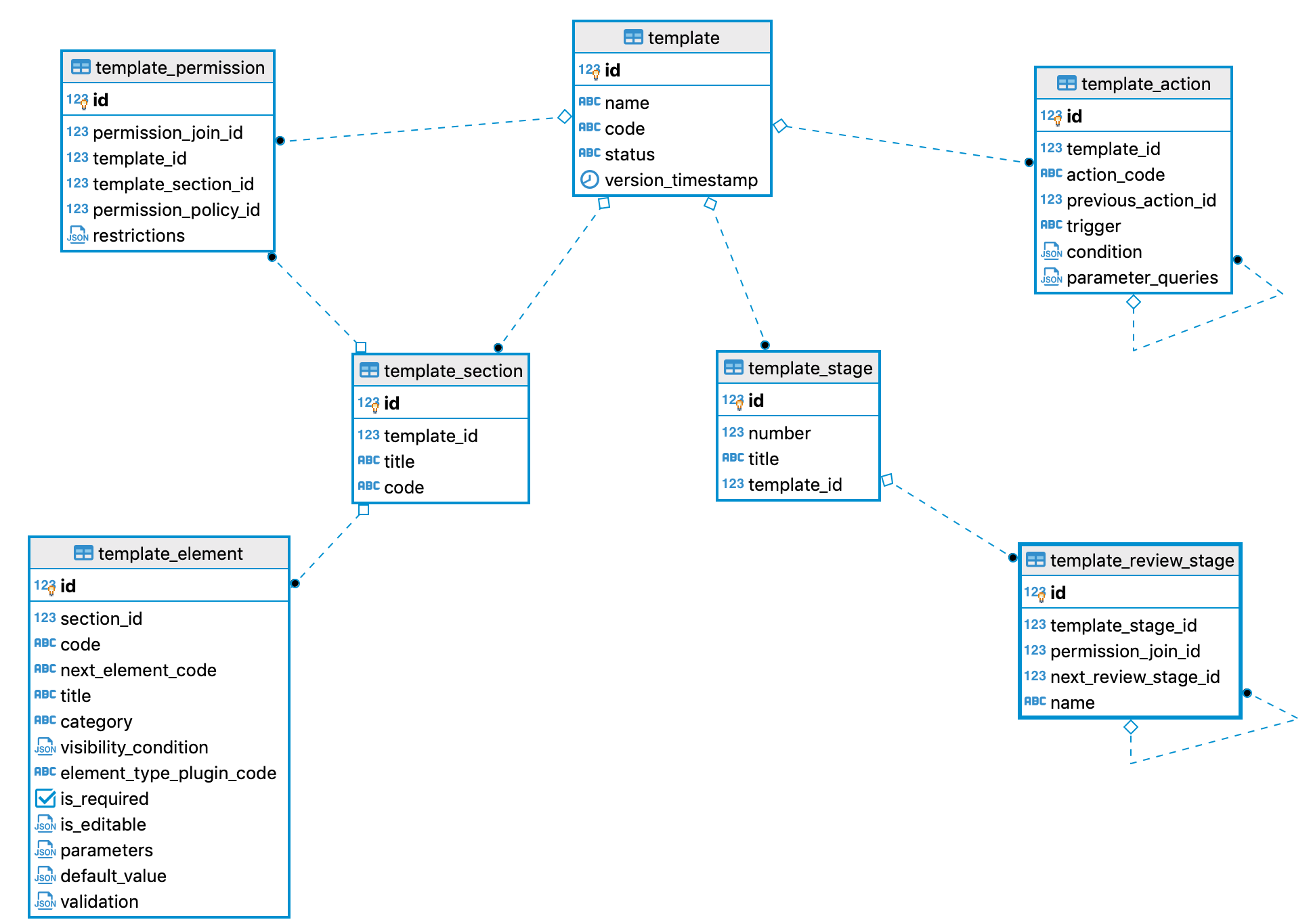-
Notifications
You must be signed in to change notification settings - Fork 1
Database Schema Template

The sections and questions required in each stage of an application is defined in the application template with the following entities.
Representation of the application template. All nested elements are accessible via joined tables and can be created or queried in the same call using the GraphQL engine.
Whenever a template is modified, the new version is saved as a new template record with a new version_timestamp. Different versions of the same base template are connected with the same code. The status field is used to indicate which version is the current available one.
The status can be 'DRAFT', 'AVAILABLE' or 'DISABLED'. The version currently active in the system is the one (and only one) marked 'AVAILABLE'.
The name is what users of the system will see as the "Application Type" -- e.g. "Drug Registration".
The is_linear is used to define the applications flow. If linear it is require each page to be complete before allowing the user to move to the next one. If not the user can go to any page, and only when trying to go to the summary page would be required that all required fields have been completed.
The start_message, optional JSON field *. When is defined the application shows a start page otherwise not. In case it is defined the start page is showed when the user clicks on the application in the list or when the user wants to start a new one.
The submission_message, optional JSON field *. It has a default general message set that will always be displayed after the application has been submitted, but a specific submission message can be defined per template.
* The JSON field is an evaluator expression that returns a markdown string. (Query evaluation not yet implemented)
To be considered: Should we check if no applications are associated with an existing template and just add changes to the current version instead?
There is one or more stages per application template. Each one is defined as a new record that point to template_id with the number of this stage (1, 2, 3, ...).
The title is dynamic, but typically would be: 'Screening', 'Assessment', 'Final Stage'.
The description should also be defined and displayed to the user at the Submission page.
Sections of the application template that contain some elements/questions. Each section can be associated with a template permission if this section requires a certain type of reviewer to check for responses from an Applicant.
See front-end docs for this spec.
See front-end docs for this spec.
The display_component_name references the UI component the applicant sees when filling in the form.
The config_component_name refers to the UI component used to create the question/element in the Template Builder.
Different users needs different permissions for acting on an application template.
For example an Applicant user would be required to be associated with a template permission in order to Apply to a specific application of a template type. Another example is a Reviewer user who would be required to be associated with a template permission in order to Review applications of a specific template type (or specific sections of the application of a template type) on a certain stage.
The template permission is the link between templates and policies (linked by permission_name) in a given stage, then users with the same permission_name will be allowed to act on the previously linked template. Each one can be for the entire template in template_id or specific sections when allowed_sections array has some section(s) defined for more specific permissions related to a section in the application.
-
template_idlink to the actual template associated with a policy which will give permissions to users later. -
permission_name_idlinks this permission to a user/organisation. -
allowed_sections[Default:NULL] Array of sections allowed (when using only to allow the permission on specific sections in the application) -
can_self_assign[Default:false] Option only for Reviewer permissiontrueif the user associated can self-assign to review applications of this template. -
stage_numberspecify stage associated for this permission. -
level_numberspecify the review level for this permission. -
restrictionswould add more specific rules. More details and examples to be added later.
The workflow of what should happen after an expected trigger in each stage of one application is defined in the application template by actions. Triggers are every change on the application, flagged by the field trigger which has associated actions. See more about triggers
The actions logic are defined inside action plugins, which execute a function to generate some change in the database. (Link to Action plugins comming soon)
The code is unique per action plugin.
The name and description are for visualisation to help Admin users selecting what action to use for an application template.
The required_parameters is the name of the fields required of local object or queries to be used when the action runs.
The template_id links the action with the application template.
The trigger describes what is the trigger associated with this action. The list of possible triggers can be found here
The action_code of the associated action plugin, where the definitions for the action are coming from.
The condition is a JSON expression that must evaluate to true for the Action to proceed.
The parameter_queries is an object mapping each of these fields from action_plugin.required_parameters to a JSON expression to provide the value to these fields.

Powered by mSupply